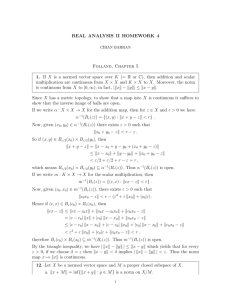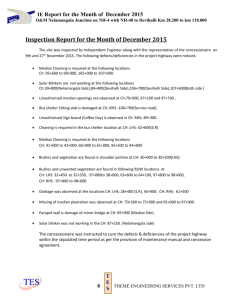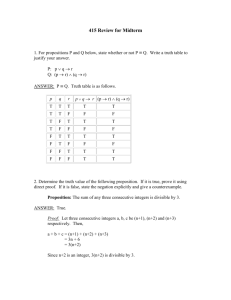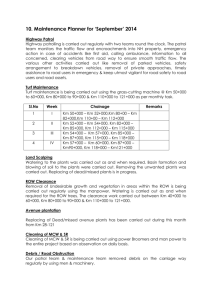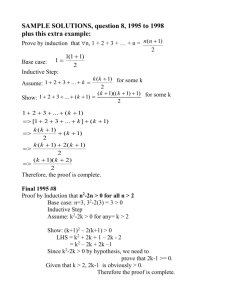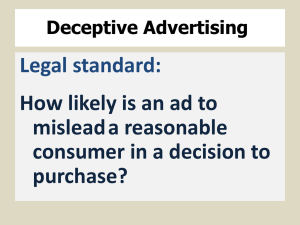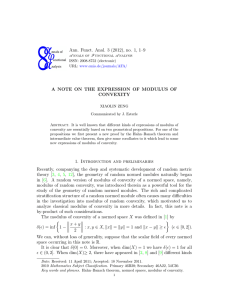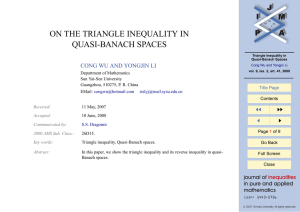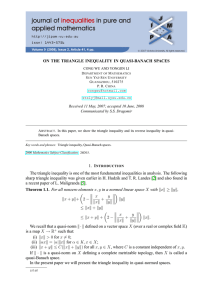G12MAN Mathematical Analysis Solutions to Question Sheet 1
advertisement
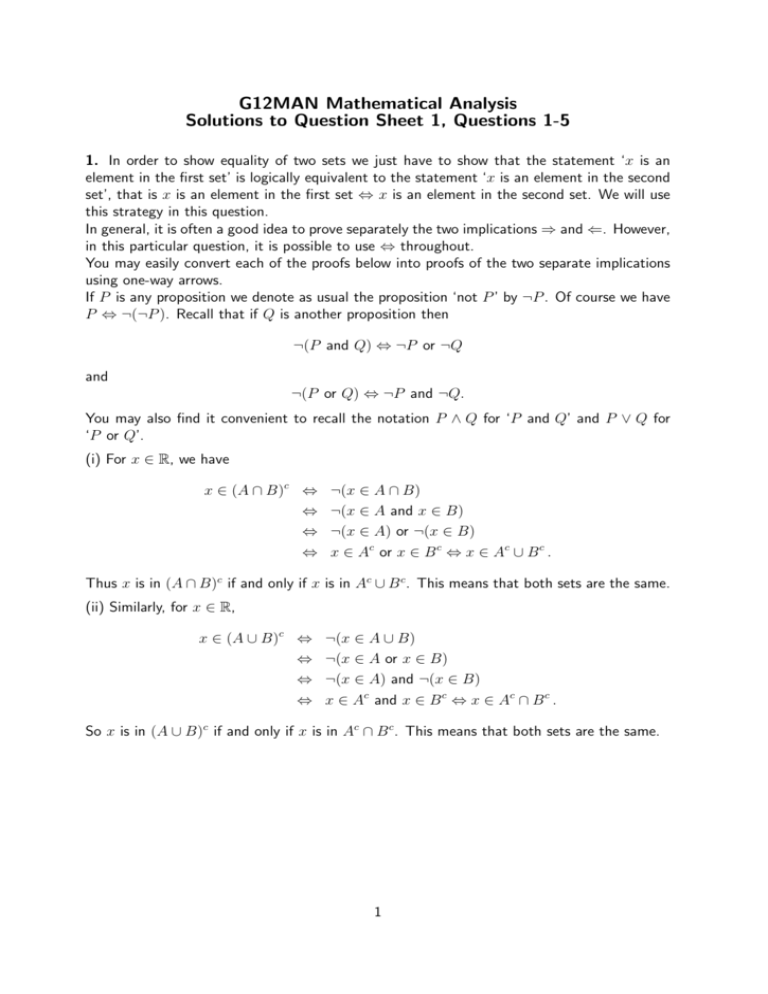
G12MAN Mathematical Analysis
Solutions to Question Sheet 1, Questions 1-5
1. In order to show equality of two sets we just have to show that the statement ‘x is an
element in the first set’ is logically equivalent to the statement ‘x is an element in the second
set’, that is x is an element in the first set ⇔ x is an element in the second set. We will use
this strategy in this question.
In general, it is often a good idea to prove separately the two implications ⇒ and ⇐. However,
in this particular question, it is possible to use ⇔ throughout.
You may easily convert each of the proofs below into proofs of the two separate implications
using one-way arrows.
If P is any proposition we denote as usual the proposition ‘not P ’ by ¬P . Of course we have
P ⇔ ¬(¬P ). Recall that if Q is another proposition then
¬(P and Q) ⇔ ¬P or ¬Q
and
¬(P or Q) ⇔ ¬P and ¬Q.
You may also find it convenient to recall the notation P ∧ Q for ‘P and Q’ and P ∨ Q for
‘P or Q’.
(i) For x ∈ R, we have
x ∈ (A ∩ B)c ⇔
⇔
⇔
⇔
¬(x ∈ A ∩ B)
¬(x ∈ A and x ∈ B)
¬(x ∈ A) or ¬(x ∈ B)
x ∈ Ac or x ∈ B c ⇔ x ∈ Ac ∪ B c .
Thus x is in (A ∩ B)c if and only if x is in Ac ∪ B c . This means that both sets are the same.
(ii) Similarly, for x ∈ R,
x ∈ (A ∪ B)c ⇔
⇔
⇔
⇔
¬(x ∈ A ∪ B)
¬(x ∈ A or x ∈ B)
¬(x ∈ A) and ¬(x ∈ B)
x ∈ Ac and x ∈ B c ⇔ x ∈ Ac ∩ B c .
So x is in (A ∪ B)c if and only if x is in Ac ∩ B c . This means that both sets are the same.
1
2. (i) This time we have to look at pairs (x, y) ∈ R2 = R × R. We have
(x, y) ∈ (A1 × B1 ) ∩ (A2 × B2 ) ⇔ ((x, y) ∈ A1 × B1 and (x, y) ∈ A2 × B2 .
Now (x, y) ∈ A1 ×B1 ⇔ (x ∈ A1 and y ∈ B1 ) and (x, y) ∈ A2 ×B2 ⇔ (x ∈ A2 and y ∈ B2 )
so that
(x, y) ∈ A1 × B1 and (x, y) ∈ A2 × B2
is equivalent to the proposition (x ∈ A1 and x ∈ A2 and y ∈ B1 and y ∈ B2 ).
On the other hand
(x, y) ∈ (A1 ∩ A2 ) × (B1 ∩ B2 ) ⇔ x ∈ A1 ∩ A2 and y ∈ B1 ∩ B2
which is equivalent to (x ∈ A1 and x ∈ A2 and y ∈ B1 and y ∈ B2 ). So again both sets are
equal.
(ii) It is not always true that (A1 × B1 ) ∪ (A2 × B2 ) = (A1 ∪ A2 ) × (B1 ∪ B2 ); for example,
consider A1 = [0, 1] = B1 and A2 = [1, 2] = B2 . Then A1 ∪ A2 = [0, 2] = B1 ∪ B2 . But
(A1 × B1 ) ∪ (A2 × B2 ) = ([0, 1] × [0, 1]) ∪ ([1, 2] × [1, 2]) ,
which is not equal to
(A1 ∪ A2 ) × (B1 ∪ B2 ) = [0, 2] × [0, 2] :
indeed. the latter contains the point (0, 2) whereas the former does not. (Exercise: draw a
diagram to make this clear.)
Actually we can even take the one-point sets A1 = {0} = B1 and A2 = {1} = B2 and obtain
a counterexample.
(iii) A × B × C = {(x, y, z) | x ∈ A, y ∈ B, z ∈ C} contains 8 elements.
Indeed, if A = {x1 , x2 }, B = {y1 , y2 } and C = {z1 , z2 } then
A × B × C = {(xi , yj , zk ) | i, j, k ∈ {1, 2} }
which we may write out in full as
{(x1 , y1 , z1 ), (x1 , y1 , z2 ), (x1 , y2 , z1 ), (x1 , y2 , z2 ), (x2 , y1 , z1 ), (x2 , y1 , z2 ), (x2 , y2 , z1 ), (x2 , y2 , z2 )} .
More generally, the number of elements in a Cartesian product of finitely many finite sets is
obtained by multiplying together the numbers of elements in the individual sets.
2
3.(i)(a) We are given that (x, x) ∈ M = A×B, so we must have x ∈ A and x ∈ B. Similarly,
we are given that (y, y) ∈ M = A × B, and so y ∈ A and y ∈ B. In particular x ∈ A and
y ∈ B so (x, y) ∈ A × B = M . Also, y ∈ A and x ∈ B, so (y, x) ∈ A × B = M .
(b) This time we are given that (x, y) and (y, x) are both in M = A×B. From (x, y) ∈ A×B
we obtain that x ∈ A and y ∈ B. From (y, x) ∈ A × B we obtain y ∈ A and x ∈ B. Since
x ∈ A and x ∈ B we have (x, x) ∈ M = A × B. Similarly (y, y) ∈ M .
(ii) Suppose, for contradiction, that S = {(x, y) ∈ R2 | 0 ≤ x ≤ 1 and 0 ≤ y ≤ x} is a
Cartesian product i.e. S = A × B for some subsets A and B of R. We have (0, 0) ∈ S and
(1, 1) ∈ S so by (i)(a) we must have (0, 1) ∈ S and (1, 0) ∈ S. But (0, 1) is not in S. This
contradiction shows that S cannot be a Cartesian product.
(iii) Suppose, for contradiction, that R is a Cartesian product. Clearly (0, 1) and (1, 0) are
both in R, but (1, 1) and (0, 0) are not. This contradicts (i)(b), and so R can not be a
Cartesian product.
4. (i) Suppose first that kxk ≥ kyk. Then kxk − kyk = kxk − kyk and we need to show
that
kxk − kyk ≤ kx − yk.
However, kxk = k(x − y) + yk ≤ kx − yk + kyk by the triangle inequality. Subtracting kyk
from both sides yields
kxk − kyk ≤ kx − yk
which proves the result if kxk ≥ kyk. If kxk < kyk then, swapping the roles of y and x, the
first part gives us
kyk − kxk ≤ ky − xk
(∗).
But kyk − kxk = kxk − kyk and ky − xk = kx − yk so (∗) implies
kxk − kyk ≤ kx − yk.
(ii) We have x = 21 (x + y) + 12 (x − y) so by the triangle inequality and homogeneity
1
1
1
1
kxk = (x + y) + (x − y)
≤ kx + yk + kx − yk.
2
2
2
2
Similarly y = 12 (x + y) + 12 (y − x) implies
1
1
kyk ≤ kx + yk + ky − xk.
2
2
Adding both inequalities together gives
kxk + kyk ≤ kx + yk + kx − yk
which is what we want.
(iii) The identity is shown as follows:
kx + yk2 + kx − yk2 =
=
=
=
hx + y, x + yi + hx − y, x − yi
hx, xi + hx, yi + hy, xi + hy, yi + hx, xi − hx, yi − hy, xi + hy, yi
2hx, xi + 2hy, yi
2kxk2 + 2kyk2 .
3
5. (i) We prove separately that the left hand side (LHS) is ≥ the right hand side (RHS) and
that RHS ≥ LHS.
(LHS ≥ RHS) If c ∈ R is an upper bound for A ∪ B then c is clearly also an upper bound for
each of the sets A and B. In particular this is true if we take c = LHS. From this we see that
LHS ≥ sup A, since sup A is the least upper bound for A. Similarly LHS ≥ sup B. Therefore
LHS ≥ max(sup A, sup B) = RHS.
(RHS ≥ LHS) For all x ∈ A we have x ≤ sup A ≤ RHS. Similarly, for all x ∈ B we have
x ≤ sup B ≤ RHS. Thus, for all x ∈ A ∪ B we have x ≤ RHS. Since LHS= sup(A ∪ B) is
the least upper bound for A ∪ B, we have RHS ≥ LHS, as required.
From LHS ≥ RHS and RHS ≥ LHS, it follows that LHS = RHS.
(ii) The statement sup(A ∩ B) = min(sup A, sup B) is often false. Consider, for example,
A = {0, 2} and B = {0, 1}. Then A ∩ B = {0} thus sup(A ∩ B) = 0 but sup A = 2 and
sup B = 1 i.e. min(sup A, sup B) = 1. There are many other examples where this equality
fails.
On the other hand sup(A ∩ B) = min(sup A, sup B) is true if A and B are bounded intervals
in R such that A ∩ B 6= ∅ (exercise).
4


